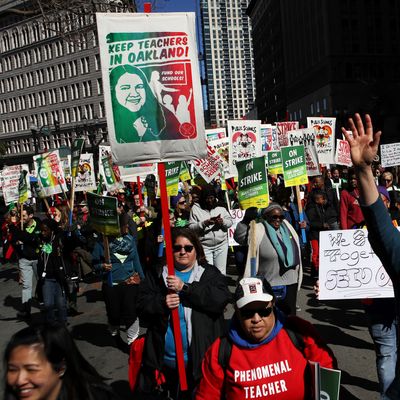
When public school teachers in Oakland, California, formally ended their weeklong strike on Tuesday, they had a lot to celebrate. The Oakland Education Association struck a deal with school district officials that will raise teacher pay by 11 percent over the next three years in addition to a onetime, 3 percent pay bump. School nurses are also getting a raise, and the district will hire more counselors and special education teachers. Striking teachers didn’t get everything they wanted; as Vox reported, the school district wouldn’t agree to halt a controversial school closure plan. But otherwise, the outcome of the Oakland strike reinforces the conclusion that walkouts are a successful strategy for teachers with grievances.
So, too, does a new report from the Center for Budget and Policy Priorities. It confirms that teacher walkouts pressured state governments into raising funds for public education. The left-of-center think tank called the boosts “substantial,” and noted that there was a particularly dramatic increase in Oklahoma, “where lawmakers increased formula funding per student by 19 percent, after adjusting for inflation.” The walkout states of Arizona, North Carolina, and West Virginia raised per pupil spending by 3 to 9 percent.
Still, it’s not all good news for public schools, even in states where teachers went on strike. CBPP found that public schools in walkout states are still significantly underfunded, which is part of a broader problem. Nationwide, schools in many states still don’t receive the level of funding they need to educate students. That’s due partly to the way the U.S. funds public education, blending federal, state, and local dollars. School spending is determined by a legislative formula at the state level, and that “formula funding” is the main source of state support for public schools. In this patchwork system, states have the discretion to heavily cut funding for public education, even if that leaves schools without the basic resources they need to function — and they wield that discretion often. Several walkouts occurred in states that have deeply slashed this formula funding since 2008.
No teacher walks out on a whim; walkouts often occurred in states that had deeply cut public school funding for years, as the CBPP report reinforces. In many cases, education funding remains well below prerecession levels, which keeps teacher pay low, and schools under-resourced and understaffed. Some states, like Arizona and Oklahoma, also introduced different school-choice programs despite their funding shortfalls. Oklahoma publicly subsidizes two scholarship programs — through direct spending and tax credits — for students who want to attend private schools; Arizona, too, runs a plethora of scholarship programs and educational savings accounts that help families pay for private school. Those programs cost tax revenue, and sometimes direct funding, that could support public education. Unions and public school educators also argue that charter schools, which are privately run public schools, divert funds from traditional public schools. The consequences of a state’s policies priorities eventually trickle down to public educators: When a teacher has to take a second job at an ice-cream shop to make ends meet, their troubles originate in large part with state government.
Though four walkout states raised formula funding after teacher protests, CBPP warns that three states did so in ways that may prove to be temporary. After last year’s walkout, Arizona’s Republican governor, Doug Ducey, signed a budget promising educators a 20 percent raise over three years. That budget, however, didn’t include new revenue to fund the raise over time. The Arizona Education Association has not dismissed the possibility of another walkout if the raise fails to materialize. The problem highlights an ongoing challenge for protesting teachers. It will be difficult to address the school-funding crisis without changing some state governments. Without electoral change, teacher victories may remain incomplete.






























